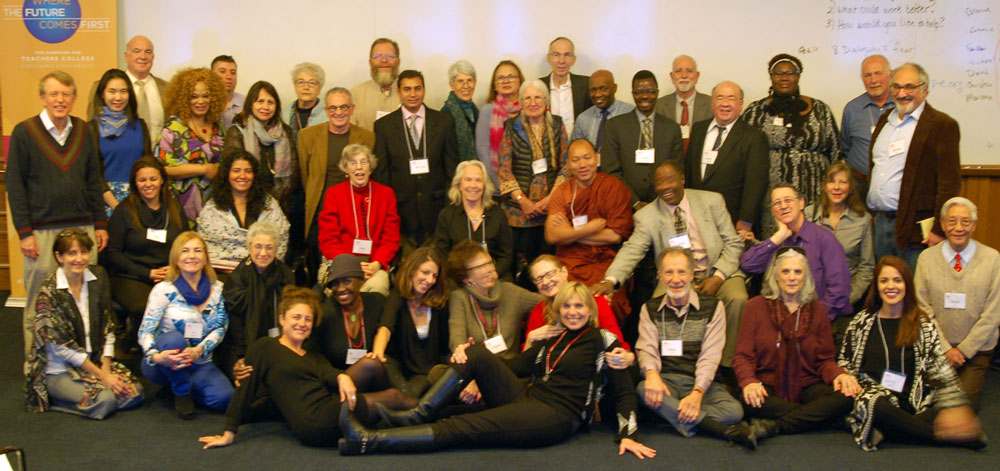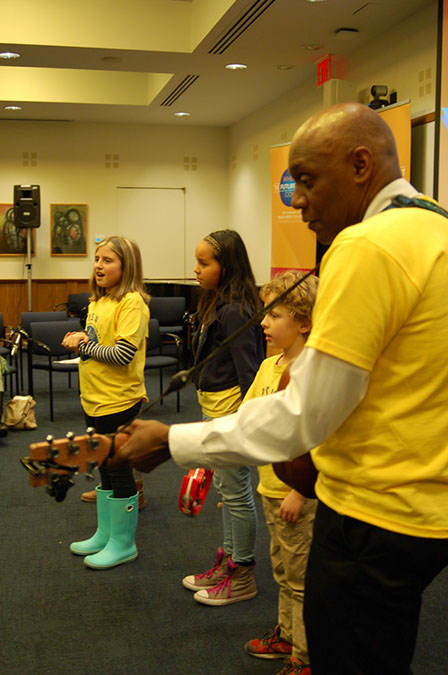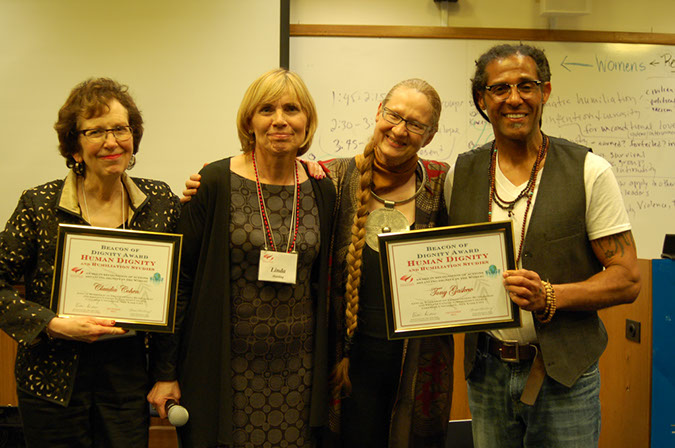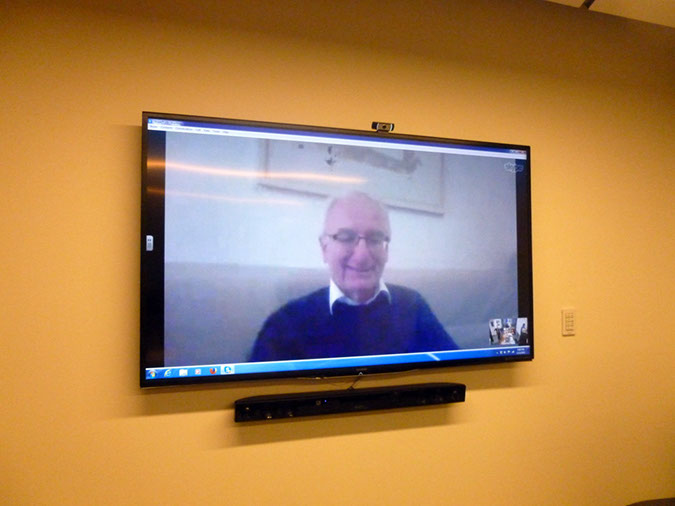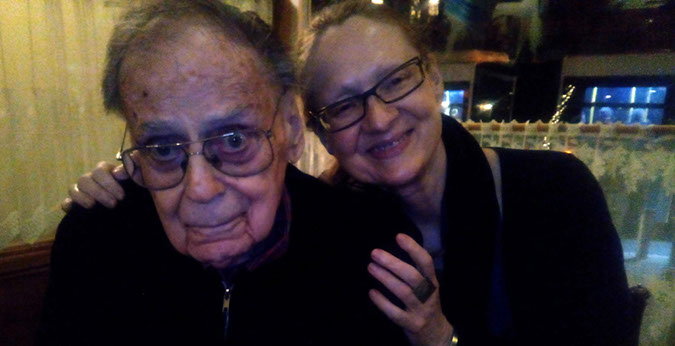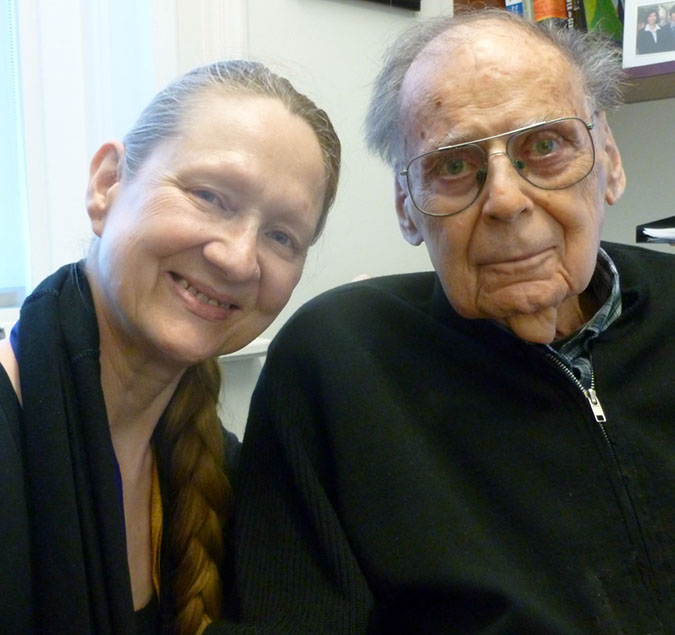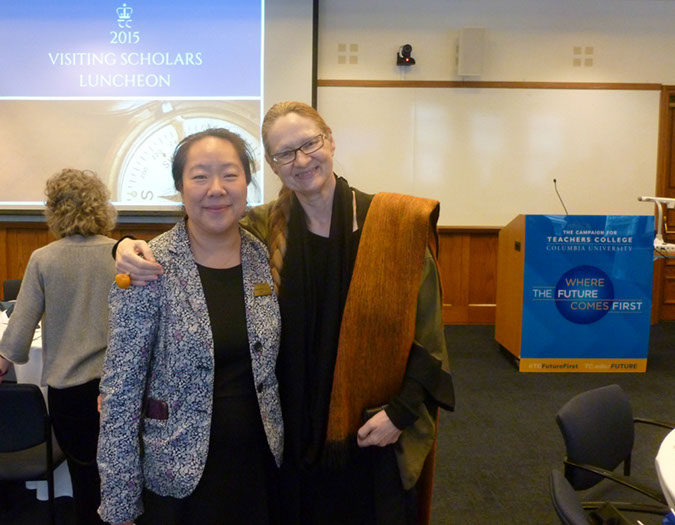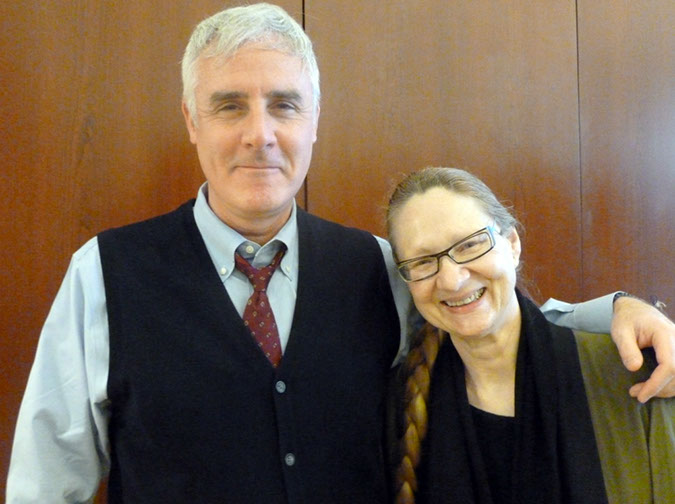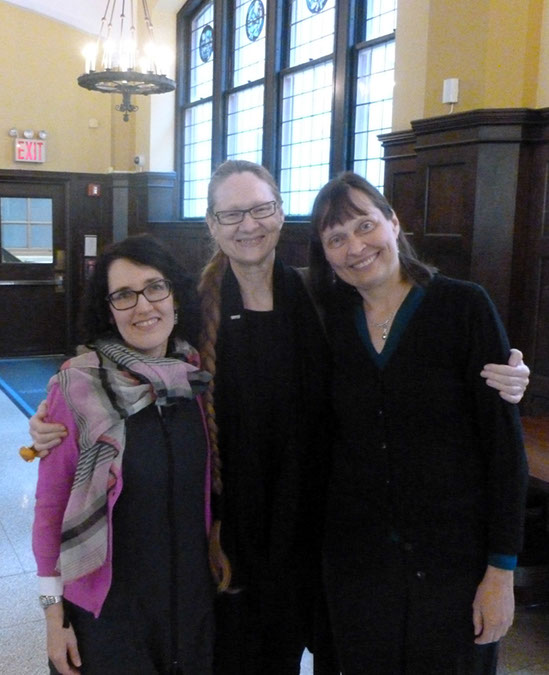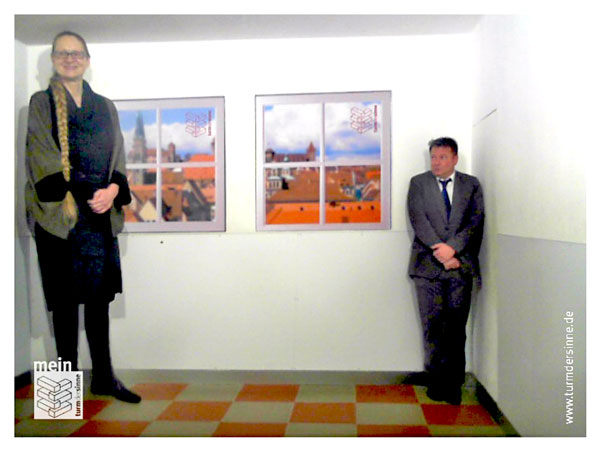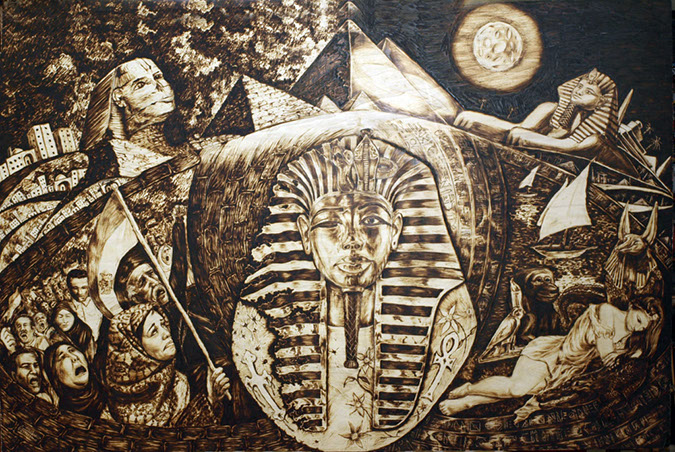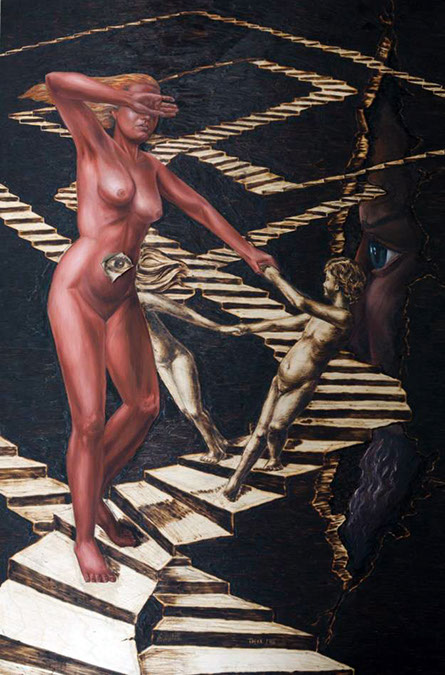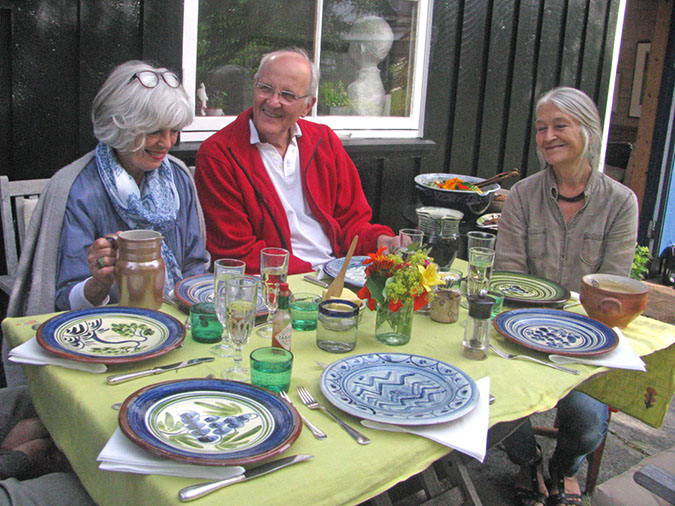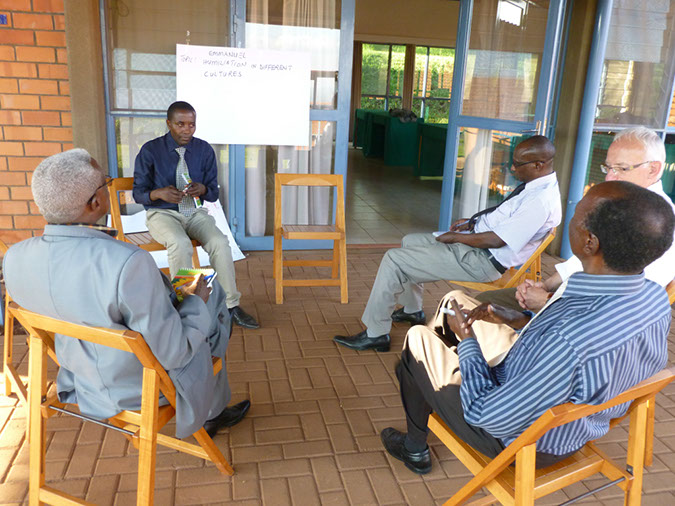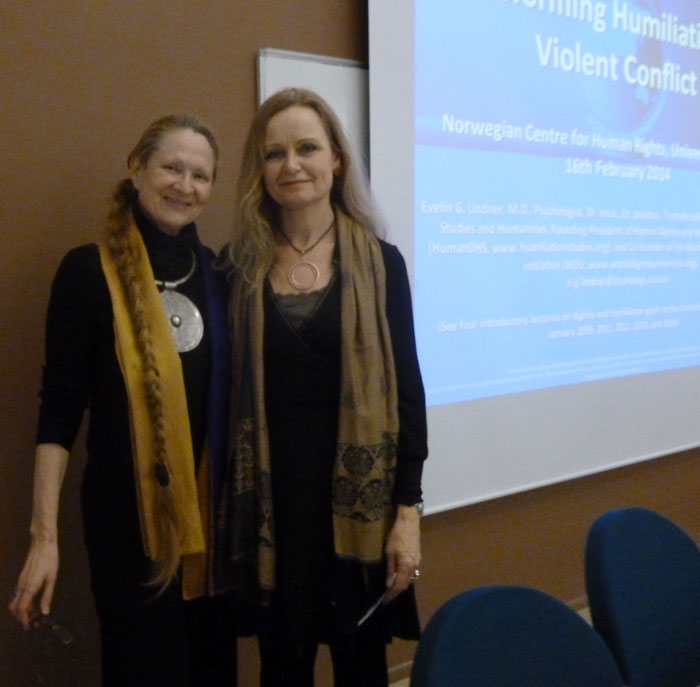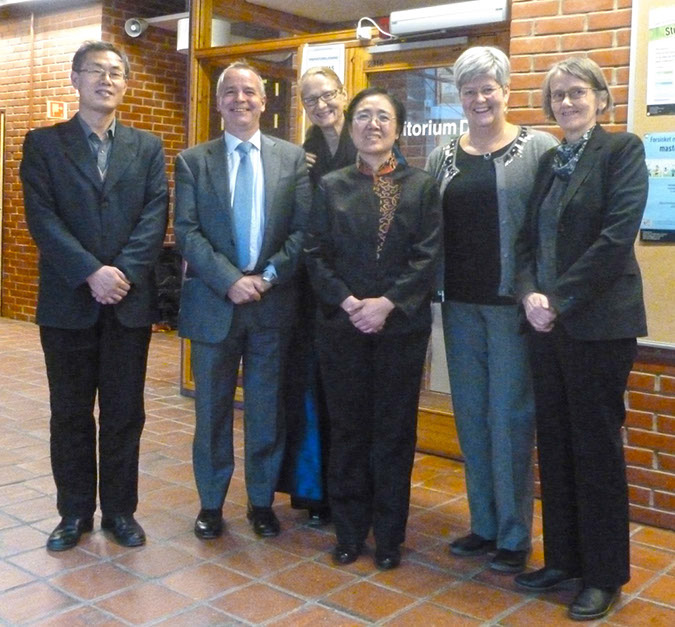Home | Who we are | Evelin G. Lindner | Evelin's pictures | Evelin's 2015 pictures
Evelin's 2015 picture documentation
2014 pictures | 2013 pictures | 2012 pictures | 2011 pictures | 2010 pictures | 2009 pictures | 2008 pictures | pictures until the end of 2007
This picture-blog is meant to document Evelin's efforts and whereabouts and share them with the HumanDHS network [read more].
See a brief legal note with regard to the permission to upload pictures with people other than Evelin.
The year starts at the bottom of this page and the most recent pictures are at the top.
15th December, 2015: It was wonderful to reconnect with Hinnerk Bruhns, Directeur de recherche émérite au CNRS, Centre de recherches historiques EHESS-CNRS,
Directeur de la revue Trivium,
Fondation Maison des Sciences de l'Homme, Paris. |
On 15th December, 2015, it was an immense privilege to be in Paris and meet with one of the most renowned experts on International Relations, Bertrand Badie, author of the book "Le temps des humiliés. Pathologie des Relations Internationales." |
On December 14, 2015, I say good-bye to my home in NY in the Upper West Side, my home since 2001, until next year. The weeks I spend here each year, squeezing in one year's NY life into a few weeks, are extremely valuable to me, a gift that enriches me enormously. THANK YOU to all of you, who give me this gift! |
On December 12, 2015, dear Judit Révèsz brought me an amazing gift, the very instrument that makes it possible for me to document our global dignity work. Only because Judit and her famous photographer-father Tamas, together with Ikhlaq, give me the courage to take photos, I am able to do so. The last camera they so lovingly gave me on December 12, 2011, was worn out by now, and here is the new one for the coming years! AN OCEAN OF THANKS! |
In December 2015, two operas at the Metropolitan Opera in New York City offered another journey into the realm of reflections surrounding contemporary dilemmas. On December 7, I was able to see the operetta "Die Fledermaus! (“the Bat”), by Johann Strauss II, which premièred in 1874 in Vienna. On December 11, I had the privilege to experience Gioachino Rossini’s 1819 opera "La Donna del Lago." See some reflections. |
On December 11, 2015, it was such a joy to be with Robert Carneiro, the Father of Circumscription Theory, at the American Museum of Natural History! While waiting for him, I took some photos of the hall... Robert Carneiro's office is across Margaret Mead's former office... |
November 29, 2015: to be invited by dear Morton and Lydia Deutsch to our annual dinner was an extraordinary pleasure, joy, privilege, and honor! |
On November 25, 2015, Puccini's opera Tosca at the Metropolitan Opera in New York City was yet another opera that defied the myth that opera is boring stuff for ignorant people who live in the past, who have too much money and too much time to invest it into snobbish status show-offs (I always get the least-costly seats with partial view half a year ahead, since I live almost without money). Also this opera was and is scandalous and educational. See some reflections. |
On November 24, 2015, it was an immense privilege to be with dear Morton Deutsch, E. L. Thorndike Professor Emeritus of Psychology and Education, and Director Emeritus of the Morton Deutsch International Center for Cooperation and Conflict Resolution (MD-ICCCR), Teachers College, Columbia University, New York City, U.S.A. |
On November 24, 2015, it was fascinating to follow a discussion with Marija Grujic and Tatjana Rosic Ilic at the Njegos Endowment for Serbian Language and Culture at Columbia University's East Central European Center and the Harriman Institute. |
On November 24, 2014, I had the immense privilege of being invited to our annual lunch by Beth Fisher-Yoshida, Academic Director of a new Master of Science in Negotiation and Conflict Resolution at The School of Professional Studies (former School of Continuing Education) under the new Dean Jason Wingard, at Columbia University, New York City, U.S.A. |
 |
On November 23, 2015, the film "Racing Extinction" by Louie Psihoyos was shown by the Advanced Consortium on Cooperation, Conflict, and Complexity (AC4), in Milbank Chapel at Teachers College, Columbia University, in an advance screening one week before its global release. |
On November 23, 2015, it was a great privilege of honoring our dear Liz Hernandez with our Beacon of Dignity Award! |
On November 23, 2015, what a fascinating and enriching evening it was to bring musicologist Hroar Klempe together with sitar master Ikhlaq Hussain! His CDs "Destiny" and "Perfume of God" can be accessed from ITunes (only downloadable music) and CDbaby (CD and downloadable music). Ikhlaq has been following the style of Ustad Vilayat Khan Gayaki, as has also his father Ustad Imdad Hussain. Ikhlaq has also been a disciple of Pandit Ravi Shankar, whose style is different. |
On November 21, 2015, it was a great experience to see Lulu, by Alban Berg, at the Metropolitan Opera. See some reflections. |
On November 19, 2015, it was such a wonderful suprise to meet our dear Christine de Michele just by chance in the neighborhood! |
On November 19, 2015, it was an immense privilege of being with dear Claudia Cohen, Senior Lecturer in the Social-Organizational Program at Teachers College and the former the Associate Director of the Morton Deutsch International Center for Cooperation and Conflict Resolution (MD-ICCCR), for our annual lunch! |
On November 18, 2015, I had the immense privilege of being invited to the annual luncheon given by Susan Fuhrman, the President of Teachers College at Columbia University in New York City, United States of America, and being able to express my great appreciation for the work she and her colleagues are doing. See also my dear "TC mother" Samantha Lu, and amazing Portia Wiiliams and Christina Joseph! |
On November 18, 2015, I had the great joy of reconnecting with dear Alba Taveras, who is now working with the Saltzman Institute of War and Peace Studies at the International Affairs Building of the School of International and Public Affairs, at Columbia University, New York City, United States of America. |
On November 18, 2015, I had the great joy of being with brilliant Peter T. Coleman, Director of the Morton Deutsch International Center for Cooperation and Conflict Resolution (MD-ICCCR), and dear colleages, see amazing Molly Clark and Charlott Macek! |
On November 14, 2015, it was a joy for which I have no words to follow dear Ariel's wonderful idea and Janet's gracious hospitality and come together for our "Gaby" gathering! Gabriela Saab, our dignity family member from São Paulo and her friend Mariana were the "reason" for our sharing, with Karen, Judit, Francis, David, Ken, and Amy! Mariana took the photo, and Gay, Jill, and Ann had already left, unfortunately, when we took that photo! |
On November 13, 2015, it was such a privilege to be with my dear MD-ICCCR family! From left Kim Nguyen, Andrew Pham, Suzanne Lipton, Danielle Coon. |
On November 12, 2015, it was such a privilege to be invited by my dear Judit Révèsz to Carol Lin of Nanlaoshu: Taiji, Qigong, Meditation. I learned Silk Reeling (see examples on YouTube)! |
On November 12, 2015, a screening of the film Seeking Truth in the Balkans opened the event "20th Anniversary of the Dayton Peace Accords: Bosnia's Uncharted Future and Balkan Lessons for Global Application," at Columbia University's Morningside Campus Rennert Hall at the Kraft Center. Keynote address Kati Marton. |
 |
November 13, 2015: The socio-political consequences of Dayton for Bosnia and the Western Balkans: Dario Cepo (University of Zagreb), James Lyon (University of Gratz), Marija Sajkas (media expert and writer), Jessie Hronesova (University of Oxford), moderated by Jasmin Mujanovic (York University) Dayton Lessons for Conflict-Stricken States: Ivana Cvetkovic Bajrovic (NED Europe director), Matthew Hodes (UN Alliance of Civilizations), Jennifer Trahan (NYU School of Global Affairs), Tanya Domi (Harriman Institute), moderated by Anna de Lellio (NYU and New School). • Please click on the picture above to see it larger. |
On November 11, 2015, it was such a privilege to be invited by Hroar Klempe to listen to Jean-Yves Thibaudet in Carnegie Hall. |
On November 8, 2015, it was such a joy to have my first annual visit to my beloved sister Judit Révèsz and brother Ikhlaq Hussain. |
On November 8, 2015, I had my annual visit to China Town. Mike Chong and Suzy Tsang had to close down their shop in 343 Canal Street, New York, NY 10013. I had the privilege of meeting with Yuan (from Guangdong Province) and Mandy (from Hong Kong) in their shop "Jewellers and Gifts, Inc.," 315 Canal Street, NY 10013. They shared with me what already Mike Chong had told me last year: there are fewer customers now, particularly after storm Sandy, yet, the biggest problem is the house rent. Yuan: "We work for the landlord..." |
On November 7, 2015, the opera Turandot by Giacomo Puccini, based on an earlier text by Carlo Gozzi, offered another journey into the realm of reflections surrounding contemporary dilemmas. As I concluded in my book on Gender, Humiliation, and Global Security, there is a deep link between gender roles and the security dilemma. In the past, it could only be the "crazy" dream of one woman, in this case Turandot, to resist war and its cruelty by using the tools of her time for denying to participate. Turandot did so by first placing the hurdles for any suitor too high, and even when one suitor succeeded to gain her hand, she implored her father to refrain from giving her away like a slave. Today, the Nobel Peace Prize is intended for people who work for ending war. And women are no longer to be treated like chattel. And what I call Big Love in my book, is more than just a personal experience of love, as for Turandot, it needs to become a global culture if Homo sapiens is to find a future worth living in. |
On November 6, 2015, it was a great pleasure to listen to Efrat Ginot giving a talk on "A Neuropsychological Model of Unconscious Processes and Therapeutic Change." The Metropolitan Institute for Training in Psychoanalytic Psychotherapy, the Metropolitan Center for Mental Health, and The Metropolitan Society of Psychoanalytic Psychotherapists had invited to this Scientific Meeting. |
On November 5, 2015, it was a great privilege to be back at Maria Volpe's Monthly Roundtable Breakfast, hosted by the CUNY Dispute Resolution Center at John Jay College and The Association for Conflict Resolution of Greater New York, with many dear friends attending, among them Reinaldo Rivera. This time, the topic was: Facilitation of the New York City Stop and Frisk Joint Remedial Process: Progress and Dialogue by Judge Ariel E. Belen (Ret.) of JAMS • Please click on the picture above, with dear Maria, Judge Belen, and Reinaldo Rivera, to see it larger. |
On November 4, 2015, it was very interesting to listen to Martin Winn speaking on "The Subject and the Social Link," in preparation for an upcoming colloquium in Tucumán in Argentina on "Psychoanalysis, Savoir-faire and the Social Link." Winn is a psychoanalyst practicing in New York and an analyst, supervisor, and member of Après-Coup Psychoanalytic Association. His explanations of Jacques Lacan's views on the discourses of the master, the hysteric, the analyst, and the capitalist were fascinating, the discourse of the capitalist not being a discourse anymore, only a solitary empty promise. I am still intrigued why psychoanalysis is so prominent in Argentina - I had the privilege of getting to know Carlos Guillermo Bigliani and his daughter Ferreira Valeria in 2012, incidentially after having had passed through Tucumán by bus on my way from Mendoza to Santa Cruz in Bolivia. While living in Egypt (1984-1991), I read all Lacan, Lévi-Strauss, Marcel Mauss, and much of the structuralists (in French) for my planned doctoral thesis (in German) on Egypt. • Please click on the picture above to see the website of this association. |
On October 31, 2015, the moral universe of the opera Tannhäuser by Wagner reminded me of the Islamic State (IS). It was altogether an event that taught me a lot. In the second break, I experienced a drama of my own. You are invited to read what happened here. • Please click on the picture above to see an announcement of this event. |
On 12th October 2015, I visited the The Memorium Nuremberg Trials, in the Nuremberg Palace of Justice / Justizpalast, a building complex in Nuremberg / Nürnberg, Bavaria / Bayern, Germany, the location of the Nuremberg trials that were held there from 1945 to 1949 for the main surviving German war criminals of World War II. I was particularly impressed by the talk given by Benjamin Ferencz in 2003 in Salzburg that was shown as a video. It was here, in court room 600, that chief United States prosecutor at the Nuremberg Trials, Robert H. Jackson, gave his historically significant Opening Statement. The Robert H. Jackson Center envisions a global society where the universal principles of equality, fairness and justice prevail. The picture at the bottom shows the head of medusa, together with the two foundations for modern law, on the left German law and on the left Roman law, both symbolized by statues of young men. At the top sin is symbolized by Adam, Eve, and the snake. • Please click on the picture above or here to see more photos. |
On 12th October 2015, I visited the Nuremberg Castle / Nürnberger Burg, in Nuremberg / Nürnberg, Bavaria / Bayern, Germany, considered to be one of Europe's most formidable medieval fortifications. It comprises three sections: the Imperial castle (Kaiserburg), some buildings of the Burgraves of Nuremberg (Burggrafenburg), and the municipal buildings of the Imperial City at the eastern site (Reichsstädtische Bauten). • Please click on the picture above or here to see more photos. |
On 12th October 2015, I visited the Way of Human Rights / Straße der Menschenrechte in Nuremberg / Nürnberg, Germany. • Please click on the picture above or here to see more photos. |
|
On 11th October 2015, I had the great privilege of being shown around by Rainer Rosenzweig in his extraordinary the hands-on science center turmdersinne ("Tower of the Sense") in Nuremberg / Nürnberg, Germany.
The aim of this impressive work is to show and make palpabe how our brain constructs what we perceive, without us being in conscious control of this process.
Knowing about this fact can help us to learn appropriate humility and caution with respect to how sure we are, or can be, of what we believe to see and to know. • Please click on the pictures at the top to see them larger, and click here to understand what happens in the Ames Raum. • Please click on the picture at the bottom to see it larger, and click here to understand the Thompson Illusion. |
|
From 9 - 11th October 2015, it was a great privilege to be invited to the 2015 Symposium "Gehirne zwischen Liebe und Krieg - Menschlichkeit in Zeiten der Neurowissenschaften" (Pdf) gemeinnützige Turm der Sinne GmbH, Nuremberg / Nürnberg, Germany. • Please click on the picture at the top to see it larger. It was kindly taken by Sylvia Gareis on 10th October. • Please click on the pictures in the middle, kindly taken by Karin Becker on behalf of turmdersinne Nuremberg on 11th October, or here to see more photos. • Please click on the pictures at the bottom, kindly taken by Jo Seuß on 11th October, or here to see more photos. Please see organizer Rainer Rosenzweig on the left side. This was the title of my contribution on 11th October 2015: "Von Demütigung zu Terror und Krieg: Erniedrigung kann zu Gewalt führen, kann sie auch zu Liebe führen?" (Pdf | Pdf) See turmdersinne's blog, see Evelin's bio, and an article in Nürnberger Nachrichten, 24th September 2015. • Zusammenfassung: Psychischer Schmerz wird im Gehirn wie physischer Schmerz verarbeitet und das Erleben anderer kann wie eigenes Erleben erfahren werden kann. Wenn andere Menschen Demütigung, Erniedrigung und Kränkung erleiden, auch wenn es geographisch weit entfernt ist, kann es wie eigene Verletzung gefühlt werden. Seit Medien und Internet das Leiden anderer immer näher bringen, wird dieses Phänomen verstärkt. Gefühle von Demütigung können zu Apathie und Depression, aber auch zu Hilfsbereitschaft und Gewaltbereitschaft führen. Nicht nur Deutschlands Geschichte, dass mit Hilfe von kollektiven Demütigungsnarrativen die Enttäuschungen Einzelner so gebündelt werden kann, dass ganze Völker in den Krieg und das Begehen von Völkermord und Terror geführt werden können. Auch die Einrichtung systemischer Demütigung kann als "Rettung" empfunden In diesem Kontext kann die Antwort mit systemischer Demütigung als "Rettung" empfunden werden - Apartheid, wie sie von einem Professor der Psychologie konzipiert wurde, ist ein Beispiel. Gefühle der Demütigung entstehen unter anderem, wenn Versprechen von Respekt nicht eingehalten werden. Menschenrechtsideale der gleichen Menschenwürde für alle, zum Beispiel, repräsentieren ein solches Versprechen, und leere Menschenrechtsrhetorik und doppelte Standards wirken doppelt kränkend. Wenn die daraus entstehenden Reaktionen fehlinterpretiert werden und zu kontraproduktiven Gegenmitteln gegriffen wird, kann es zu unnötigen Kreisläufen der gegenseitigen Demütigung führen. Bewusstseinsbildung im Sinne eines Dietrich Bonhoeffer, Paulo Freire oder Nelson Mandela kann helfen, von einer Kultur des Krieges, in der Demütigung anderer als Lösung gesehen wird, zu einer Kultur der globalen Einigkeit zu gelangen, in der kulturelle und ökologische Vielfalt im Kontext gleicher Menschenwürde für alle gedeihen kann. Wissenschaftler, die die Einsicht und Demut besitzen, sich ihrer gesellschaftlichen Abhängigkeit und Verantwortung bewusst zu sein, können dabei helfen. Dr. Dr. Evelin Lindner ist promovierte Medizinerin und Psychologin. Sie ist Mitbegründerin der World Dignity University Initiative und mit der Uni Oslo, der Columbia University in New York und dem Maison des Sciences de l‘Homme in Paris assoziiert. Als Gründungspräsidentin von Human Dignity and Humiliation Studies, einem weltweiten transdisziplinären Netzwerk von Wissenschaftlern und Praktikern, ist sie für den Friedensnobelpreis 2015 nominiert. |
On 8th October 2015, I honored the chief United States prosecutor at the Nuremberg Trials, Robert H. Jackson, bei paying a visit to the house where he lived at the time of the trials. It was in this location that chief United States prosecutor at the Nuremberg Trials, Robert H. Jackson, prepared his historically significant Opening Statement. The Robert H. Jackson Center envisions a global society where the universal principles of equality, fairness and justice prevail. • Please click on the picture above to see it larger. |
On 7th October 2015, I visited the Documentation Centre Nazi Party Rally Grounds. • Please click on the pictures above to see them larger. |
It was a great privilege to be together with my dear and esteemed PhD supervisor Reidar Ommundsen on 12th August 2015 in Oslo! • Please click on the picture above to see it larger. |
It was a great privilege to be together with Inga Bostad, Director of the Norwegian Centre for Human Rights of the University of Oslo, Norway, and Zehlia Babaci-Wilhite, just on her way to Berkely, on 11th August 2015 in Oslo! • Please click on the picture above to see it larger. |
27th July and December 2015: It is such an honor that George Riad Krohn created such a wonderful water color painting of a photo he took when he and his wife Elisabeth paid me a visit on 27th July on Nøtterøy. He then made this painting in December 2015. George Riad Krohn was born in Alexandria in Egypt 1981. He barely avoided being arrested for making his freed motives. He is now living in Norway with his family. |
|
In July 2015 Ragnhild Nilsen was honored with the Beacon of Dignity Award for her longstanding work for dignity around the world. She received the award from the World Dignity University Initiative, which is part of the Human Dignity and Humiliation Studies (HumanDHS) network, for her countless efforts – and this is only one example among very many – for her volunteer work with fair trade, bringing dignity to thousands of textile workers in the world, especially in Egypt. She organized a Fashion Revolution Day on April 24, 2015, commemorating the 1320 textile workers who died in Bangladesh when their factory collapsed. She has done great work with global leadership development especially for women in countries where women do not receive adequate support. Last but not least, it is her musical dignity work as artist Arctic Queen, which is being recognized with this award. Her touching music, art installations, and beautiful poetic writing awaken us from meek complacency and move us to transformative and healing action. We thank Ragnhild Andersen for recording this video with Ragnhild and Evelin Lindner, Founding President of HumanDHS, on 30th July 2015. The date of the official award ceremony was 28th July. The ceremony was concluded by this video event. The event took place in Flekkerøya, in the south of Norway. Norwegian: I juli 2015 blir Ragnhild Nilsen æret med Beacon of Dignity Award for hennes mangeårig arbeid for verdighet verden rundt. Hun får prisen fra World Dignity University initiativet, som er del av Human Dignity and Humiliation Studies nettverket, for hennes mangfoldig innsats, for eksempel for hennes frivillige arbeid med fair trade og for å gi verdighet til mange tusen tekstilarbeidere i verden, spesielt i Egypt. Hun fikk på plass Fashion Revolution Day den 24. april 2015, til minne om 1320 tekstilarbeidere som døde i Bangladesh da fabrikken deres kollapset. Hun har gjort et stort arbeid med global lederutvikling spesielt for kvinner i land hvor kvinner ikke får tilstrekkelig støtte. Sist, men ikke minst er det hennes musiske verdighets arbeid som artisten Arctic Queen som blir anerkjent med denne prisen. Hennes berørende musikk, kunstneriske installasjoner og vakre, poetiske bøker vekker oss fra feig selvgodhet og beveger oss til transformasjon og helbredende handlinger. See here a quote from the very personal message on the occation of awarding the Beacon of Dignity Award to Ragnhild, words formulated on by Evelin in her capacity as Founding President of the global Human Dignity and Huniliation Studies fellowship 28th July 2015: "Dearest beloved Ragnhild! Please accept the following words, which I want to inscribe deep into your heart today! I want that the entire planet hears my words, that your family and all your friends hear these words! You, my dearest Ragnhild, YOU are a Beacon that makes the Universe shine as never before, YOU are a Beacon of Dignity as the world has seen NONE BEFORE! I know you now since 21 years, and very few people had the opportunity to be given such deep insight into your thoughts and deeds as I do. I can attest that names such as Nelson Mandela and Mahatma Gandhi come to mind when one thinks of you! YOU, my dearest Ragnhild, are a soul, a human being, a woman, who brings profound healing into this world, and you do this in many different ways! You do this on all levels of being and activity that is imaginable, from wonderfully artful singing, writing, and speaking, to even the most down-to-earth economic creativity! I wish to make you cry, and I wish to make all people who are listening now, cry. I wish that you all, who listen now, cry from being touched, deeply touched in your hearts and souls, by the love that YOU, dearest Ragnhild, give to us all, give to this world. It is a love that is so unconditional, so unending, so unlimited, so deep, so universal, and so warm that only eyes of love can fathom its depth. I feel profoundly privileged of having been allowed to be in the light of your love since 21 years, my dearest sister, and I have seen how profoundly healing your love has touched others, in the moment they opened up to it. I know, many of us are so busy, so much part of our modern 'rat-race' that we have no time to look at the sky. YOU, dear Ragnhild, you do more than look at the sky, YOU bring the sky to all of us! This award shall honor and acknowledge you for all the years of love work and dignity work that you have gifted to us and this world, and it shall open the eyes and hearts of all those people whom you will meet on the path that your life will lead you in the coming decades. I call upon all of you, who listen now, to go to dear Ragnhild in the course of this evening, and honor her, and open your heart to the deep love that Ragnhild can teach us all. Congratulations to YOU, dear Ragnhild, also with another recognition! We have good news for our global dignity movement: as representative of our work, I have been nominated for the 2015 Nobel Peace Prize. We are very thankful for this nomination as it is an wonderful sign of appreciation for our work. Congratulations also to YOU, dear friend, because our dignity work is based on the African Ubuntu philosophy of 'I am because of you!' and YOUR dignity work is crucial for our global dignity movement! This nomination is about encouragement for all of us." • Please click here or on the pictures above to see more photos. |
On the 17th July, 2015, it was such a privilege that dear Gerdelin invited us all into her paradise on Brøtsø south of Oslo, in Norway! Mai-Bente, Fredrik, Lisbeth, Per, Trine, and I, we shared all our adventures! |
|
Still pictures:
(Important note to our conference particants: During our conference, we asked for your permission to have your pictures posted here, however, if you changed your mind since, either in total or for specific pictures/videos, please let us know! Thank you! Since we wish to walk the talk of dignity, it is very important for us to do our utmost in respecting everybody's privacy. We refrain from gathering written permissions from you during our conferences, since we value the building of mutual trust in relationships, and we also would like to refrain from contributing to an ever more bureaucratic and legalistic society.) |
    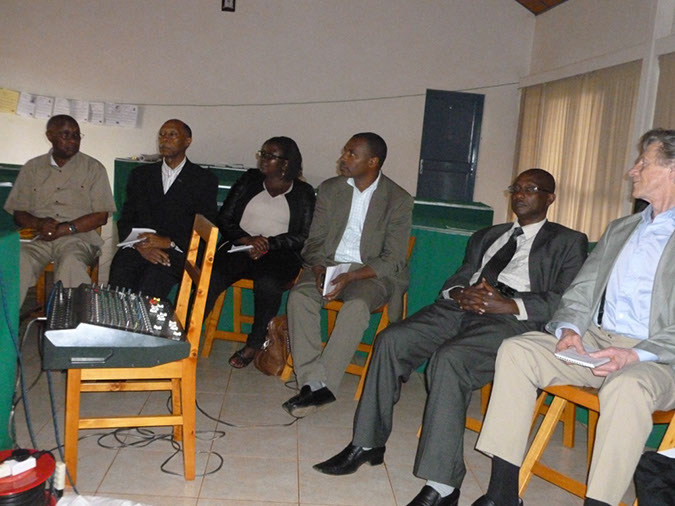  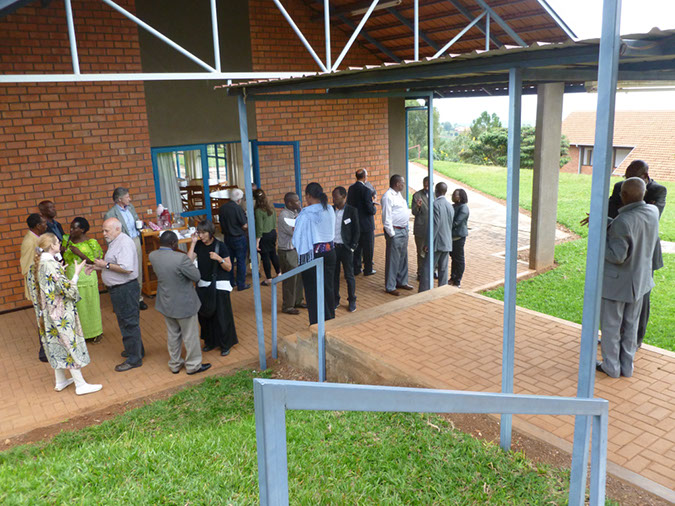     |
| Day One, 2nd June 2015 The conference started at NURC on 2nd June at 9.00 in the morning. From there, participants proceeded to the Foyer de Charité Sainte Trinité de Rebero Kigali, where the main conference took place, first with introductions, and then with the planning of the Dignilogues for the rest of the conference. • Please click on the pictures at the top or here to see all the 82 photos from Evelin's camera Thank you most warmly, dear Nira Shahaf, for taking such wonderful photos! • Please click on the pictures at the bottom or here to see all 32 Dignilogue posters from Evelin's camera • See also our Dignilogue Themes and our Appreciative Introductions |
|
| Day Two, 3rd June 2015 We first visited the Kigali Genocide Memorial of Gisozi, then were generously invited by NURC to have lunch in Umubano hotel, before returning to the Foyer de Charité to have Dignilogues. • Please click on the picture above or here to see all 50 photos kindly taken by Magnus Haavelsrud • Please click on the pictures in the middle or here to see all 33 photos of Day Two from Evelin's camera (Thank you most warmly, dear Nira Shahaf, for taking such wonderful photos!) • Please click on the picture at the bottom or here to see all 32 Dignilogue posters from Evelin's camera • See also our Dignilogue Themes and our Appreciative Introductions |
                    • Please click on the photo above to see the article |
Day Three, 4th June 2015, Public Event |
|
Day Three, 4th June 2015, Public Event • Please click on the photos at the top to see the video. |
          |
Day Four, 5th June 2015 Day Four, 5th June 2015: Dignilogue Summaries |
  |
| On 11th June 2015, I had the privilege of reconnecting with dear Jean-Damascène Gasanabo, Director General of Research and Documentation, Centre on Genocide, National Commission for the Fight against Genocide (CNLG). See two photos taken in his office in Kigali. Please see his most recent publication: Gasanabo, Jean-Damascène, David J. Simon, and Margee M. Ensign (Eds.) (2014). Confronting Genocide in Rwanda: Dehumanization, Denial, and Strategies for Prevention. Kigali, Rwanda: The National Commission for the Fight Against Genocide, Republic of Rwanda. • Please click on the pictures avove to see them larger. |
  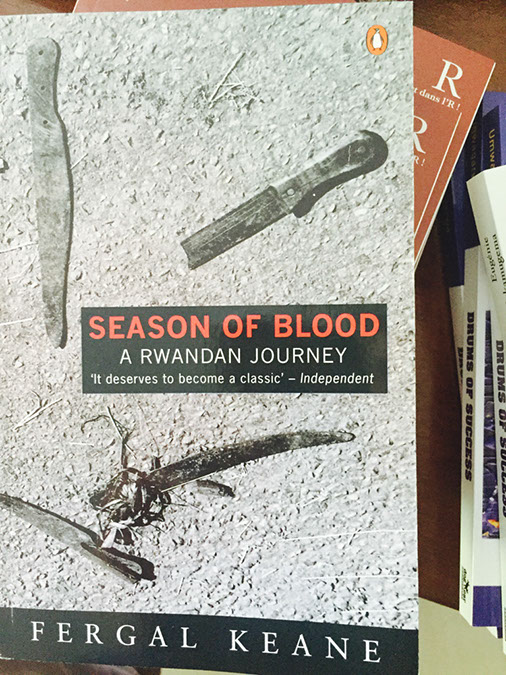  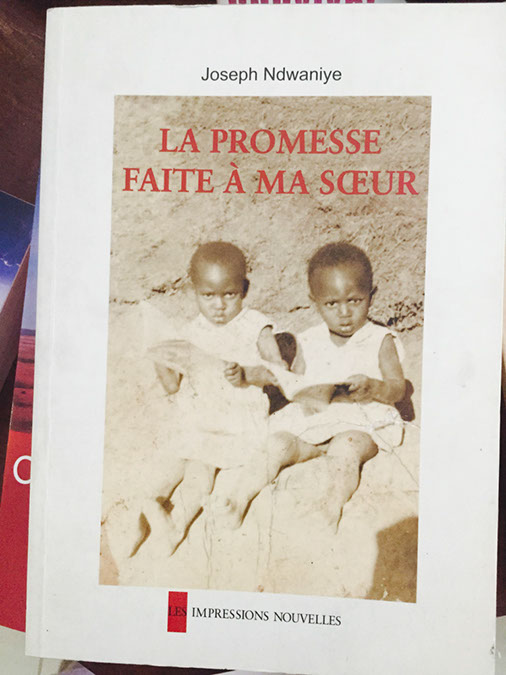 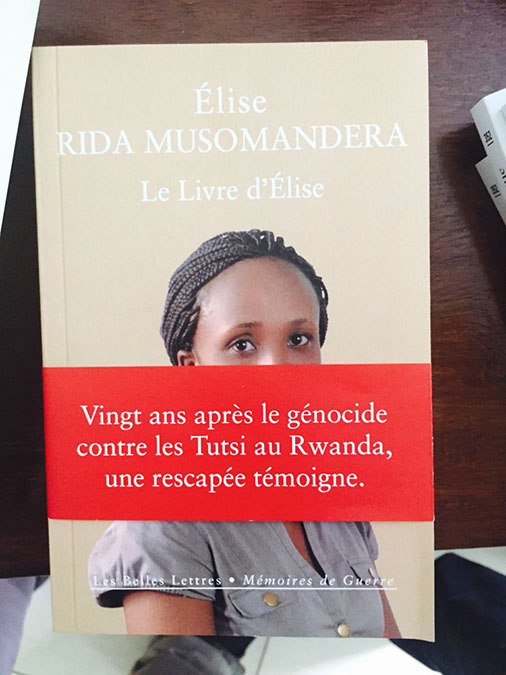     |
| Please click on the pictures above ore here to see all 50 photos kindly taken by Magnus Haavelsrud. Here you see the books he found in the bookstores of Kigali. |
  |
| Dear Emmanuel Ndahimana and Damas say good-bye at the airport of Kigali on the eve of 30th June 2015. • Please click on the pictures above or here to see all photos. |
|
On 16th May 2015, our esteemed Emmanuel Ndahimana and Evelin met with Soeur Gertrude Twagirayezu (she wears an African dress on the photos above) and Soeur Romaine to see whether our conference could take place on their premises, the Foyer de Charité (Caritas) in Rerbero-Kigali. Later, Evelin also met Soeur Mediatrice, Soeur Marie Ange, and Prêtre Pierre Claver Nkusi. It is a wonderful place, Evelin can attest for that, since she had the honour of being welcomed to live in the neighbouring convent since she arrived in Kigali on 1st May. It is beautiful and calm, and choosing this location will also express our wish to honor Felicitas Niyitegeka, who gave her life and was killed for standing by her Tutsi sisters in the genocide that ravaged Rwanda in 1994, targeting Tutsi, together with moderate Hutu who were opposed to the killing.
Our dear Father Jean d'Amour Dusengumuremyi, who has also brought Evelin to this wonderful environment, has written a book about Felicitas, on which Uli Spalthoff has worked day and night to publish it in time before our conference in our Dignity Press. Uli has offered to bring 100 copies with him in his suitcase. The book is titled 'No Greater Love: Testimonies on the Life and Death of Felicitas Niyitegeka'. The aim is to create a foundation in the name of Felicitas. |
Over the years, I have observed, all around the world, how wonderful handmade souvenirs are being replaced by mass-produced souvenirs, often made in China. At the top you see wonderful items from Rwanda in 2015, which might soon share the fate of my beloved Egyptian souvenirs from 1984-1991 that you see at the bottom. They can not longer be found in Egypt; I looked for them in vain in 2007. |
Let me take this picture as an example of a Tuscan-themed house (I am not an expert on the exact naming). I find them everywhere in Kigali, as much as I saw them in South Africa, and are told that the wealthy build them from Kinshasa to Bangui. |
In June, I tried to find the birds that sing here in Rwanda so beautifully, but failed. I had admired them already in 1999, when I came first to Burundi and then to Rwanda. On 20th and 21st of June 2015, I recorded some of their singing. They even sing with my beloved sisters! Whoever knows these birds, please help me! I did not succeed in taking pictures of them. How do they look like? What are their names? |
On 30th May 2015, I went through the garden and took photos of the three kinds of avocado trees and their harvest... |
On 29th May 2015, I took photos of our cows returning home... |
On 20th May 2015, I took photos of the wonderfully fresh milk and butter that the sisters produce! |
On 16th May 2015, our esteemed Emmanuel Ndahimana kindly helped me buy hair conditioner and a new suitcase (the old one had been damaged in its last journey from Amsterdam to Kigali, after five years of tough travel all over the world). On the way, I took pictures just to share some impressions of Kigali, of its beautiful views, its changing weather, and, above all, its unparalleled cleanliness. Everywhere else on the globe, it is particularly plastic waste that litters urban and rural spaces, not here! It is almost unbelievable! I remember what I learned from the German Ambassador, who gave me the honor of meeting him on 7th May, about another example of public care for the common good, namely, a public health care system. In Africa, it only exists in Rwanda and South Africa, I learned. Everywhere else in Africa, people who have no means to pay for medical services are left to their own devices. |
On 13th May 2015, my dear sisters, who so kindly gave me shelter and love, suprised me with lovely birthday flowers from the surrounding nature here in Kigali, Rwanda! You see me sitting with the photo of Félicité, who gave her life in the genocide that ravaged Rwanda in 1994, targeting Tutsi, together with moderate Hutu who were opposed to the killing. Our dear Father Jean d'Amour Dusengumuremyi wrote a book about her, published in our Dignity Press, titled 'No Greater Love: Testimonies on the Life and Death of Felicitas Niyitegeka'. When I arrived in the convent on 1st May, I was immensely happy to see Felicitas' photo standing on the table in the dining room. Sister Antoinette had put it there to remind everybody of the need to place love first, loving service, if needed until death. Felicitas was an Auxiliaire de l'Apostolat, a laïque engagée, who had dedicated herself to a celibate life to serve the common good with love. She was the responsible head of the Centre Pastoral St. Pierre of the Diocèse de Nyundo in Gisenyi. She saved the lives of many Tutsi, and, at last, she chose to die together with the Tutsi women who were in her care and whom she could not save. |
On 13th May 2015, our dear Linda Hartling sent out our "Take a Look" letter containing reflections on the 2015 Nobel Peace Prize nomination of our global dignity work. |
I am living here on a hill above Kigali in the Kicukiro District, not far from the Nyanza Genocide Memorial Centre. The Kicukiro District has altogether six genocide memorials, among them the Nyanza memorial site, home to about 11,000 victims of the 1994 genocide. The other is Rebero Genocide Memorial where 14,000 are buried, including politicians who were killed during the genocide. The Nyanza site is a symbol of international failure to protect Tutsi from being killed. |
Starting on 1st May 2015, I was most lovingly cared for by the Soeurs Dominicaines in their convent in Rebero-Kigali, Rwanda. I am infinitely thankful to Father Jean d'Amour Dusengumuremyi for suggesting to our dear Emmanuel Ndahimana to bring me to the sisters and ask them whether they would welcome me in their midst. You see the wonderful view from their building. |
On 27th February 2015, this was the special view out of the window of the just landed airplane in Hannover, Germany... |
On 25th February 2015, I had the great privilege to be invited by Gerdelin Bodvin to Opera Simon, with Sunniva Bodvin as scenographer and costume designer. |
On 16th February 2015, I had the great privilege of sharing my thoughts in a talk titled "Transforming Humiliation and Violent Conflict" at the Norwegian Centre for Human Rights, University of Oslo, introduced by Inga Bostad, see the announcement. Warm thanks go to Rachel Aspögård for video-taping the talk, see the video. |
On 11th February 2015, I had the great privilege of being invited to the Spring Up Musical, en fengende og hjertewarm historie om to ungdomsgjenger som barker sammen i Oslo Gater. I et dramatisk og uheldig øyeblikk knivstikker Lukas en jente, og han takker ja til samfunnstraff i Kina, der kampsporten gir livet endring og nye perspektiv. Regi: Elin Høyholm, manus: Tormod Ugelstad, musikk: Peter Baden, produsent: Ingrid Danbolt. Benjamin Hiley spiller Lukas i hovedrollen, Alexander Brill i en mindre rolle og med Allan Hiley og Ola Thingstad som har laget promoteringsvideoen Spring Up, er familien Hiley og NTS godt representert! See also http://operaen.no/. |
On 11th February 2015, I had the great privilege of sharing my thoughts in a guest lecture at the Department of Psychology of the University of Oslo, Norway. I thank Ole Jacob Madsen for inspiring me with his important work and for introducing me. And I thank Marit, Nathalie, Noorit, and Ellinor for a wonderful gathering after the event. Warm thanks go to Per Ole Bjørnstad for video-taping. |
On 2nd February 2015, it was a great pleasure to have an hour with Kristian Harpviken, Director of PRIO, the International Peace Research Institute in Oslo, Norway. |
On 31st January 2015, our dear Trine Eklund celebrated her important birthday! It is a great privilege to be part of her family, together with Mai-Bente Bonnevie, Fredrik Heffermehl, Gerdelin Bodvin, and to meet, for the first time, also Sonja Lid! |
On 27th January 2015, I had the great privilege of being welcomed by Ragnhild Nilsen and her daughter in their home in Oslo, Norway. |
On 26th January 2015, I observed how my ideas of an office cockpit or internet cockpit, ideas I could not pursue due to lack of time, are manifesting, at least partly, in different places, and with different aspects of it. On the left side, you see chairs at Værnes airport in Trondheim, Norway, and on the right side Massage-O-Matic wellness facilities at Schiphol airport in Amsterdam. |
On 23rd January 2015, Jingyi Dong defended her doctoral thesis titled "A Study of Rural Students in the Higher Education System in China in Relation to Their Context" at the Department of Education of the Faculty of Social Sciences and Technology Management of the Norwegian University of Science and Technology (NTNU). Her academic supervisor was Magnus Haavelsrud. The title of her trial lecture was "Dignity and Democracy: A Vision for the Future of Rural Students in the Higher Education System in China." Jingyi Dong defended her work brilliantly and her ideas will become important for rural students in China, for higher education in China, and for society in general both within and outside of China. I had the honor of being the first opponent in her defence. |
In January 2015, I had the great privilege of being welcomed to Trondheim, Norway, by my beloved Klempe family.
On 22nd January, I took a little tour, paying a visit to Nidarosdomen and Olav Tryggvason. |









